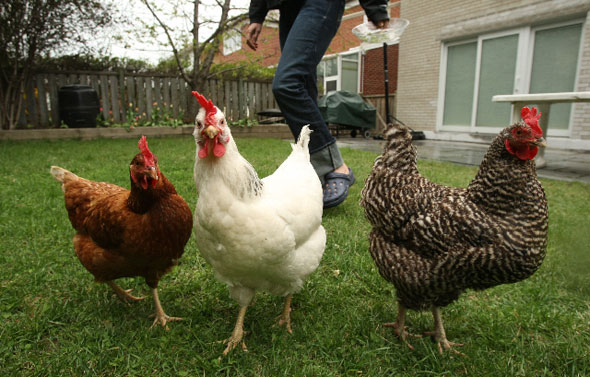It's that time of year....time for gingerbread, presents, mall parking chaos, and that quintessential holiday beverage: eggnog. Barf. Personally, I hate the stuff, but many people love it, and it fits in with this blog, so here's a recipe from a well-trusted source, Saveur magazine.
(taken from saveur.com )
SERVES 6
2 cups milk
3/4 cup sugar
Pinch salt
1 vanilla bean, split lengthwise
4 eggs, separated
1 cup bourbon
2 oz. dark rum
1 cup cold heavy cream
Freshly grated nutmeg
1. Put milk, 1/2 cup of the sugar, and salt into a medium heavy-bottomed saucepan. Scrape seeds from vanilla bean into pan, then add pod. Heat over medium heat, stirring until sugar has dissolved, about 10 minutes.
2. Whisk egg yolks in a mixing bowl until pale yellow. Slowly whisk 1 cup of the hot milk mixture into yolks. Gradually add egg–milk mixture back into milk mixture in saucepan and cook, stirring constantly with a wooden spoon, until thickened, about 5 minutes. Strain into a large bowl and set aside to let cool. Add bourbon and rum, cover, and refrigerate eggnog until cold.
3. Whisk egg whites in a mixing bowl until frothy, then gradually add remaining sugar, whisking constantly until stiff but not dry peaks form. In another bowl, whisk cream until stiff but not dry peaks form. Fold whites and cream into eggnog. Pour into cups and sprinkle with nutmeg.
Sunday, December 18, 2011
Thursday, November 10, 2011
lifestyles of the rich and famous
take two of my favorite (favourite for you Canadians) things, eggs and opals. What do ya get?
Now for sale at Tiffany & Co, this little pink opal egg designed by Jean Schlumberger in the 1960s can be yours for the measly price of $1,250 (plus tax). If only it came in blue.
Now for sale at Tiffany & Co, this little pink opal egg designed by Jean Schlumberger in the 1960s can be yours for the measly price of $1,250 (plus tax). If only it came in blue.
Friday, November 4, 2011
"An egg today is better than a hen tomorrow" Part VI - The Rest
aka, I've been fairly comprehensive up to this point, and now I'm starting to get busy with other life things...too busy to focus so heavily on a project that I myself won't be able to do for at least several years. So I'm doing a cop-out: here's a fantastic link, from backyardchickens.com about everything else you will need to know about raising chickens. This includes diseases, if you get them from egg vs. chick, suppliers, all that fun stuff.
So I hope you enjoyed my random six-part informational section about the backyard hen house! I know I did, and I will definitely be using all this research sometime in the near(ish) future.
So I hope you enjoyed my random six-part informational section about the backyard hen house! I know I did, and I will definitely be using all this research sometime in the near(ish) future.
Thursday, November 3, 2011
embroidered eggs
This awesome piece of embroidery is done by Lithuanian artist, Severija Incirauskaite. Don't Panic magazine has a pretty cool interview featuring this crafty artist, as well as other samples of her work.
Wednesday, October 26, 2011
Sunday, October 16, 2011
Thursday, October 6, 2011
"An Egg Today is Better Than a Hen Tomorrow": Part V The Feed
A happy, healthy chicken will lay the best eggs. And think of it this way: whatever you feed your chickens, you will eventually also eat in their eggs, so it's best to feed them the best foods possible. Chickens are also natural foragers/peckers and will destroy any vegetable and flower garden around (as well as kill off both pest and beneficial insects), it is best to keep them at least somewhat contained so they don't destroy your entire yard/garden/neighbor's yards.
So getting back to the topic: what is best to feed chickens? The real question is, how much work/money are you willing to put in? Here are some options:
- The best form of chicken food is probably going to be organic. You can either buy the organic pre-made stuff online or from specialty stores, but that will definitely cost you a pretty penny. Some brands you can look into that are 100% certified organic are Fertrell's, Homestead Organics, and Nature's Best Organic Feed.
- If you want to just make your own chicken feed (which is recommended, since then you have it all in bulk, save money, and know how fresh it is), there are TONS of resources both online and in your local library. Here is one recipe taken from Greener Pastures Farm:
*** It's not necessary to follow this recipe exactly... just make sure your birds are getting enough protein, which is predominant in the hard red wheat and the legumes. Free-range birds usually find plenty of protein from bugs, etc.
2 parts whole corn (in winter this is increased to 3 or 4 parts)3 parts soft white wheat3 parts hard red winter wheat1 part hulled barley1 part oat groats1 part sunflower seeds (in winter this is increased to 2 parts)1 part millet1 part kamut1 part amaranth seeds1 part split peas1 part lentils1 part quinoa1 part sesame seeds1/2 part flax seeds1/2 part kelp granulesfree choice of granite gritfree choice of oyster shellI store the above items in 6 bins; the corn in one, both types of wheat are mixed in the 2nd bin, barley in the 3rd, oat groats in the 4th, sunflower seeds in the 5th, and the remaining seeds and grains are mixed into the 6th bin. I leave the granite and oyster shell in the bags they come in. I then scoop out what I need into a 5 gallon bucket, and pour back and forth from one bucket to another until mixed well.
- Ronda Jemtegaard - Greener Pastures Chickens, http://www.greenerpasturesfarm.com
Tuesday, October 4, 2011
"An Egg Today is Better Than a Hen Tomorrow": Part IV The Coop
So you've figured out that you can have chickens. The neighbors say "ok", you found the breed you want...now where to put them. Well, this all depends: obviously if you live in the country, you will have a lot more options due to more space available; so for the sake of this blog and people like myself who will most likely live in more urban environments, I have found some ideas for the urban chicken coop.
Backyardchickens.com has some wondeful coop ideas for small, medium, and large coops.
- This lovely yellow coop includes the plans, dimensions, and a step-by-step photo arrangement of how to make this exactly.
- This amazingly charming and detailed coop even has a built in little pen for the chickens to scratch around in.
- If you want something a bit more utilitarian without the frills (but still very nice to look at), then this one might be more to your taste.
Unfortunately, I do not know how this one was made, but it's pretty amazing.
Take a look around their site, seriously. There are tons of amazing chicken coop ideas for all types of yards and budgets.
Backyardchickens.com has some wondeful coop ideas for small, medium, and large coops.
- This lovely yellow coop includes the plans, dimensions, and a step-by-step photo arrangement of how to make this exactly.
- This amazingly charming and detailed coop even has a built in little pen for the chickens to scratch around in.
- If you want something a bit more utilitarian without the frills (but still very nice to look at), then this one might be more to your taste.
Unfortunately, I do not know how this one was made, but it's pretty amazing.
Take a look around their site, seriously. There are tons of amazing chicken coop ideas for all types of yards and budgets.
Tuesday, September 20, 2011
"An Egg Today is Better Than a Hen Tomorrow": Breeds o' Chickens Part III
Just how many chicken breeds are there? Wikipedia says "hundreds", Yahoo Answers says the same "hundreds" (since it was just copy-pasted from Wikipedia), Poultrypages.com says over 75....to put it simply, there are a lot of different types of chickens out there. So which ones are the best for what I/people who may want an urban hen house of just a few want?
Some factors to consider: good egg layer, friendly, not aggressive - think pet that lays eggs. Here are some of the more popular breeds:
 1. Rhode Island Red:
1. Rhode Island Red:
- Hardy against cold weather
- A good egg layer ( average 200 per year, 5-7 per week)
- Good with kids, but can get a bit aggressive if provoked/annoyed/poked/harassed.
- Can be affectionate, especially with familiar people.
- If free range/run, eggs can be too big to fit into a carton
- Egg color = brown
2. Barred Plymouth Rock ("Barred Rock"):
- Hardy against cold
- Decent egg layers (4 per week)
- Calm around familiar people
- Will run from predators
- "Smart and plucky" (sounds very chicken-ish)
- Good brooders (meaning they will incubate eggs)
- Egg color = brownish pink
 3. Easter Eggers (sorta Ameraucanas, but not):
3. Easter Eggers (sorta Ameraucanas, but not):
- Not a specific breed
- Egg colors = blue to green to olive to aqua and sometimes even pinkish
- Very friendly, especially with kids
- Hardy against the cold
- Decent egg layer (4 per week)
- Known to have a "fun" personality
 4. Sussex:
4. Sussex:
- Come in a variety of colors (Brown, Buff, Light, Red, Speckled, Silver, White and Coronation)
- Great against cold weather
- Forage well and are economical eaters
- Friendly and easy to handle
- Can't really fly away, easy to fence
- Curious (will follow you around)
- Decent egg layers (4 per week)
- Egg color = brown
For more information on these breeds and others, visit My Pet Chicken
Some factors to consider: good egg layer, friendly, not aggressive - think pet that lays eggs. Here are some of the more popular breeds:
 1. Rhode Island Red:
1. Rhode Island Red: - Hardy against cold weather
- A good egg layer ( average 200 per year, 5-7 per week)
- Good with kids, but can get a bit aggressive if provoked/annoyed/poked/harassed.
- Can be affectionate, especially with familiar people.
- If free range/run, eggs can be too big to fit into a carton
- Egg color = brown
2. Barred Plymouth Rock ("Barred Rock"):
- Hardy against cold
- Decent egg layers (4 per week)
- Calm around familiar people
- Will run from predators
- "Smart and plucky" (sounds very chicken-ish)
- Good brooders (meaning they will incubate eggs)
- Egg color = brownish pink
 3. Easter Eggers (sorta Ameraucanas, but not):
3. Easter Eggers (sorta Ameraucanas, but not):- Not a specific breed
- Egg colors = blue to green to olive to aqua and sometimes even pinkish
- Very friendly, especially with kids
- Hardy against the cold
- Decent egg layer (4 per week)
- Known to have a "fun" personality
 4. Sussex:
4. Sussex:- Come in a variety of colors (Brown, Buff, Light, Red, Speckled, Silver, White and Coronation)
- Great against cold weather
- Forage well and are economical eaters
- Friendly and easy to handle
- Can't really fly away, easy to fence
- Curious (will follow you around)
- Decent egg layers (4 per week)
- Egg color = brown
For more information on these breeds and others, visit My Pet Chicken
Tuesday, September 13, 2011
"An Egg Today is Better Than a Hen Tomorrow". Are You Allowed to Have an Urban Hen House? Part II
Perhaps the first thing you should look into is the most obvious: are you legally allowed to have a hen house where you live? Of course, countryside/more rural residences are going to be a lot more lenient than their urban counterparts - so it's always best to just check first to see what is and is not permitted, and what steps are necessary to have one if you are allowed.
For example: Minneapolis, MN (taken from Minneapolis Animal Care & Control - MACC)
- Are you allowed to have an urban hen house? Yes, but you need a "small animal permit"
- What do you need to do?
1. Define the number and type of each bird to be kept on the property.
2. Obtain written consent from 80% of your neighbors within 100 feet of your property. A copy of the consent form and the addresses needing permission can be generated by the MACC.
3. Allow the MACC to inspect the area where you wish to keep the birds for zoning and living requirements.
4. All animals must be vaccinated and licensed
- Is there an application fee? Yes, $50
- Is there a renewal fee? Yes, $40 = one year, $150 = five years
Unfortunately Toronto, you are not allowed to have urban chickens, as they are one of the "prohibited animals" - i.e. Galliformes. (Schedule A to Ch. 349 - Prohibited Animals)
However, there has been talk of changing this law as of recently, so hopefully this will be amended...after all, pigeons and rabbits are ok. Weird.
If you are in the US and are interested in keeping back yard chickens, there's a great website that can help lead you in the right direction: http://www.backyardchickens.com/laws/search.php
Good luck!
For example: Minneapolis, MN (taken from Minneapolis Animal Care & Control - MACC)
- Are you allowed to have an urban hen house? Yes, but you need a "small animal permit"
- What do you need to do?
1. Define the number and type of each bird to be kept on the property.
2. Obtain written consent from 80% of your neighbors within 100 feet of your property. A copy of the consent form and the addresses needing permission can be generated by the MACC.
3. Allow the MACC to inspect the area where you wish to keep the birds for zoning and living requirements.
4. All animals must be vaccinated and licensed
- Is there an application fee? Yes, $50
- Is there a renewal fee? Yes, $40 = one year, $150 = five years
Unfortunately Toronto, you are not allowed to have urban chickens, as they are one of the "prohibited animals" - i.e. Galliformes. (Schedule A to Ch. 349 - Prohibited Animals)
However, there has been talk of changing this law as of recently, so hopefully this will be amended...after all, pigeons and rabbits are ok. Weird.
If you are in the US and are interested in keeping back yard chickens, there's a great website that can help lead you in the right direction: http://www.backyardchickens.com/laws/search.php
Good luck!
Sunday, September 11, 2011
"An Egg Today is Better Than a Hen Tomorrow": an Introduction to the Backyard Hen House
Farm fresh eggs - that golden orange yolk, that hormone-free goodness. We all would love to have them, but unless you have a very large wallet or live on or near a farm, you're a bit out of luck. Perhaps this reason (and the rising popularity of a self-sustained living) is why more and more people are building backyard hen houses? If I had the space for it, I would do it in a heartbeat. That is why I have decided to create a series of posts about the backyard hen house - for those that can do it, but do not know how (and for myself in the future).
For those of you who do not know/have never noticed the difference, please take a gander at this photo and article from Spoonful New York's blog:
Look forward to more in-depth posts about how to start your very own backyard hen house in the near future.
For those of you who do not know/have never noticed the difference, please take a gander at this photo and article from Spoonful New York's blog:
Left = farm fresh. Right = supermarket
Look forward to more in-depth posts about how to start your very own backyard hen house in the near future.
Tuesday, September 6, 2011
great name, great store
One of my all time favorite stores here in Toronto's Kensington Market, Good Egg sells a wide selection of general and specialty cook books, cooking supplies, specialty classes, and fun little knickknacks.
As the store says:
"Good Egg is a shop dedicated to those who like to eat."
If you live in Toronto, or plan on being in the area, definitely check them out.
As the store says:
"Good Egg is a shop dedicated to those who like to eat."
If you live in Toronto, or plan on being in the area, definitely check them out.
Tuesday, August 30, 2011
FINALLY A NEW POST!
Whoa, it's been way too long! Trust me when I say I've been insanely busy these past few months. Too busy. My right eye won't stop twitching...
ANYWAY!
If you know me, then you know I absolutely adore/respect/idolize Gordon Ramsey. Yes, he is sort of a prick, but he's a prick who knows his stuff (which I think is a-ok).
Here is a fantastic Gordon Ramsey video recipe for scrambled eggs, which my boyfriend and I have tried and swear by for the perfect, wet, fluffy scrambled egg. None of that sad, Embassy Suites-esque greasy, heavy, overly saturated with Sysco crap eggs. It's especially nice with chives, smoked salmon, and a few small dollops of goat cheese. Enjoy!
Friday, June 3, 2011
stress
Sorry for the long delay between updates. Life has been pretty stressful lately, so here's a quick update: I need an egg-shaped stress ball. That would be perfect. More to come later, I promise.
Sunday, May 1, 2011
National Egg Month (?)
According to the American Egg Board (yes, such a thing does indeed exist...), May is National Egg Month.
What exactly IS National Egg Month? Why is there a National Egg Month? According to the American Egg Board and the Incredible Edible Egg:
"Because sales tend to slow at that time"
There ya go.
So, what can you do with National Egg Month (besides eat eggs)? Well, you can buy some really nifty things like:
- A National Egg Month magnifying ruler! (Ooo!)
- A National Egg Month mini notepad! (Wow!)
- A National Egg Month "a-mazing" maze! (Swell!)
- A National Egg Month chicken-shaped yellow scrubber! (...part of me actually kind of wants this...)
Monday, April 25, 2011
food with eggs = happiness
Travis and I prowl the internet for food recipes all of the time. And by all of the time, I mean way more than we should...
THAT being said, Travis found this **amazing** site based on David Chang's world famous Asian fusion restaurant, Momofuku. In it, lucky reader, you can find all of Momofuku's recipes from Chang's cookbooks that the authors have all tried to make themselves. TONS of them call for pork, and TONS of them call for eggs, all of which equals food heaven for people like myself.
Some highlights:
Pan-Roasted Asparagus (way better than hollandaise)
Green Onion-Oil Deviled Eggs
Lychee Lime Mint Sorbet (no eggs, but it looks too good not to share)
Thursday, April 21, 2011
茶碗蒸し = yum
When I was but a wee little Sus, my grandma "Mary" (aka Setsuko) would make me this amazing eggy dish whenever she happened to be visiting from California. I LOVE this dish. So tasty and simple, it warms your whole body with its protein-filled silky-smooth goodness.
Here is a great version of the recipe from rasamalasia.com:
Ingredients:
4 medium shrimp (or skip if you want it to be veggie)
4 gingko nuts (optional - I usually don't)
2 inch carrot
3 oz chicken breast (or tofu for the vegetarians)
1 teaspoon sake
1 teaspoon soy sauce
2 fresh shiitake mushrooms (thinly sliced, stalks discarded)
4 gingko nuts (optional - I usually don't)
2 inch carrot
3 oz chicken breast (or tofu for the vegetarians)
1 teaspoon sake
1 teaspoon soy sauce
2 fresh shiitake mushrooms (thinly sliced, stalks discarded)
For the custard:
3 extra large eggs, beaten
2 cups water*
1/2 teaspoon dashi-no-moto (aka dried dashi pellets you add to water) (or equal amount of dashi stock)* (or veggie stock for the vegetarians)
1 tablespoon sake
1 tablespoon soy sauce
1/2 teaspoon salt
Water
2 cups water*
1/2 teaspoon dashi-no-moto (aka dried dashi pellets you add to water) (or equal amount of dashi stock)* (or veggie stock for the vegetarians)
1 tablespoon sake
1 tablespoon soy sauce
1/2 teaspoon salt
Water
*Ratio of eggs to dashi stock/water is 1:3. The above measurement of water is for reference only.
Method:
1. Blanch prawns and set aside.
2. Cut the carrot slices into maple leaf shapes . Blanch in salt water and drain.
3. Cut the chicken into small cubes and marinate in sake and soy sauce for 15 minutes.
4. Put all egg custard ingredients in a bowl and mix with chopsticks and strain into a bowl.
5. Bring a steamer to boil and then set the heat to very low.
6. Divide the chicken, shiitake, prawns and carrots among four ramekins (or small oven-safe cups. Think creme brulee cups). Divide the egg mixture among the ramekins. Put the scallion on top and cover each ramekin with aluminum foil.
7. Steam on low heat for 15 minutes. Insert a tooth pick into the egg and if it comes out clear, it’s done.
Tuesday, April 19, 2011
6 uses for eggs (besides eating and decorating)
Instructables.com has a great list of 6 unusual uses for eggs:
1. Hair care. Gross? Very, but eggs, being high in protein, make good conditioning masks. Take some egg whites, beat them with a whisk till frothy, add a bit of olive oil, put on your hair, leave for 20 minutes, rinse, and voila! Conditioning. And, if you want to smell more fresh than freshly laid, add some scented oils to the concoction. Supposedly this also works for dogs (feeding them scrambled eggs) and skin care (whisk whites or yolks with water and use it as face wash - alternate each night).
2. Arts and Crafts Glue. Egg whites as they dry become very sticky. or for papier-mâché, egg whites + flour + sugar + a little alum.
3. Plant water (from making hard or soft boiled eggs). let it cool first (obviously), then go ahead! Shells are full o' calcium, so besides the water, save the shells for composting.
4. Ghetto band-aid and first aid. From a hard-boiled egg, use the thin membrane between the white and the shell to cover your wound. Also, if you get a bruise, use a freshly hard-boiled egg to rub over the bruised surface. The warm pressure dissipates some of the pooling blood.
5. Leather cleaner. Gentry rub hard-boiled egg whites onto leather (supposedly any leather), and wipe off with a damp cloth. Makes your leather clean and shiny!
6. Jewelry cleaner (not sterling silver). From Instructables: "First boil an egg or two, depending on the size of your jewelry. You only need the hardboiled yolk...Break up the yolks a bit, and place at the bottom of a container that you can easily seal. Set a wire rack over the yolks so you can hold your jewelry above without directly touching the yolks. If you don't have a rack, use some paper towels. Place your jewelry in, and seal the container. Let sit for a day (or longer if you want it darker), and wash silver with a bit of soap. Heads up: the yolks will smell pretty nasty after sitting out, so be sure to open your container in a well-ventilated area." There you go.
Monday, April 18, 2011
Egg Carvings
 Well, that's not accurate. They're not so much carvings as they are...burnings? Etchings? I know a small laser light is used, but I'm not sure what to properly call these.
Well, that's not accurate. They're not so much carvings as they are...burnings? Etchings? I know a small laser light is used, but I'm not sure what to properly call these. ANYWAY, big thank you to my friend Leah for sending this my way. The artist, Cai.Sculptor (aka Zhong Gui Cai), is a genius. He uses eggs from ducks, geese, quail, chickens, and ostriches to make these elaborate "carvings".
Sunday, April 17, 2011
Egg Jams
 |
| Egg art by John Lamouranne |
...as in songs about eggs. Found this awesome list of 10 (10!) songs about the great egg. From Wolfmother to Autechre to Ween to Tom Waits, many thanks to The Music Fix.
the simple pleasures
Aside from eggs, I love noodles. The two together? Heaven. Add a bit o' Korean spices, and make it quick and easy as hell to cook, and you've got complete happiness. So, I thought I'd share with you, dear reader, one of my all time favorite simple pleasures: instant ramen with the perfect soft-boiled egg.
Now, I cannot take credit for coming up with this perfect soft-boiled egg recipe...that goes to my lovely boyfriend, Travis. But trust me when I say "perfect" - soft, cooked white, encapsulating the golden yolk waiting to ooze out. The flavor, once released from the egg, adding a depth and richness to the instant noodle broth that will make you forget that it was ever labeled "instant".
(However, I will add that buying a better quality instant ramen does make a huge difference. I'm a big fan of the Korean ones - the spice makes the broth less salty.)
What you need:
- 1 small pot
- 1 egg (per person)
- a timer
- water (duh)
1.) It is best to have both the pot of water for the broth/noodles and the pot of water with the egg (just enough water to cover the egg) started at the same time.
2.) Once the pot of water with the egg is boiling, start your timer for EXACTLY three minutes, as for the pot of water for the broth/noodles, add the broth and condiments first, but not the noodles yet, and lower the water to a simmer.
3.) After three minutes, take the pot of water with the egg off the stove and with cold water pouring into the pot, count for 30 seconds while pouring out the hot water slowly
4.) At this point, throw the noodles into the simmering water and stir to make sure all of the noodles are cooking.
5.) With the back edge of a butter knife, gently tap the top of the egg to form a ring of cracks. Then, under slowly trickling cool water, CAREFULLY peel the egg and place it into the bowl you will use for the soup.
6.) Pour the broth and noodles from the pot into the bowl with the egg, grab a soup spoon and some chopsticks, and enjoy!
 | |
| my egg is a little overcooked here |
Saturday, April 16, 2011
Commercially Produced v. Free Range v. Organic v. Mutant v. Candy v. Sasha Eggs
Picture this:
You're at the grocery store, and you want to buy some eggs. So, you meander over to the egg section of the dairy aisle with your cart full of groceries, watching out for unsupervised young children and people who are in a world of their own. Finally, you make it to the egg section.
What do you see?
Way too many options. Omega-3 enhanced, commercial, free-range, organic...it's a lot. Now, if you want to buy the cheapest eggs, your best (and only) bet is usually the commercially produced ones.
However, if you were wondering "Ok, what's the difference between all of these, and why the hell would I want to spend $5 on a dozen eggs?!" this little bit o' info is for you:
- According to MSNBC and Mother Earth News Magazine, Free-range and organic eggs contain
1.) 1/3 less cholesterol
2.) 1/4 less saturated fat
3.) 2/3 more vitamin A
4.) 2 times more omega-3 fatty acids
5.) 3 times more vitamin E
6.) 7 times more beta carotene
7.) more humane conditions for the chickens, blah blah blah
With conventionally produced chickens and eggs, the toxins from the grains fed to the chickens, such as pesticides, herbicides, fungicides, and fertilizers, are all stored in the fat of the chickens (a reason to not buy conventional chickens). Because of the lack of exercise due to being confined in small cages at all times, conventional chickens not only do not lose their fat accumulated (with all that fun toxic stuff), but they are pumped full of antibiotics to be kept healthy-ish. So, when you eat their eggs...you're eating all of that other fun stuff too.
BUT, this does not explain the differences between free range and organic! According to trusted.md:
Organic chickens are fed organic grains and are medication-free, so when you eat the eggs, you aren't eating all of the other toxic stuff with it. HOWEVER, "organic" does not mean exercise, nor does it specifically tell you what the chickens were fed other than "organic" material.
Enter in free-range. The free-range chickens are allowed to run around outside in a pen (exercise), and will generally eat things found in the outdoor pen that they are supposed to eat, such as grass, bugs, etc (ie not other chickens or grain).
Friday, April 15, 2011
If Indiana Jones looked for eggs...
...he'd find pysanky. Pysanky, the traditional Ukrainian Easter egg, is by no means a new tradition based in Christianity. Try more like 6000BC and the Trypilljan culture. While obviously it is impossible to find examples of actual egg pysanky, numerous ceramic relics have been found dating back to about 1300 BC.
Each symbol, color, line, plant, and animal motif has specific meaning and purpose. When you think about current day Easter egg packs, and the bunnies, chicks, flowers, and color pots, it all starts to slowly make sense. Of course, these things are incredibly badass looking versus just being purple with some squiggle lines.
This site has an amazing breakdown of each symbolic meaning found on a pysanky. From suns to moons to crosses to horses to the color brown...the next time you look at an extravagantly decorated Ukrainian Easter egg, try to decipher what exactly the artist was saying.
Subscribe to:
Posts (Atom)











































